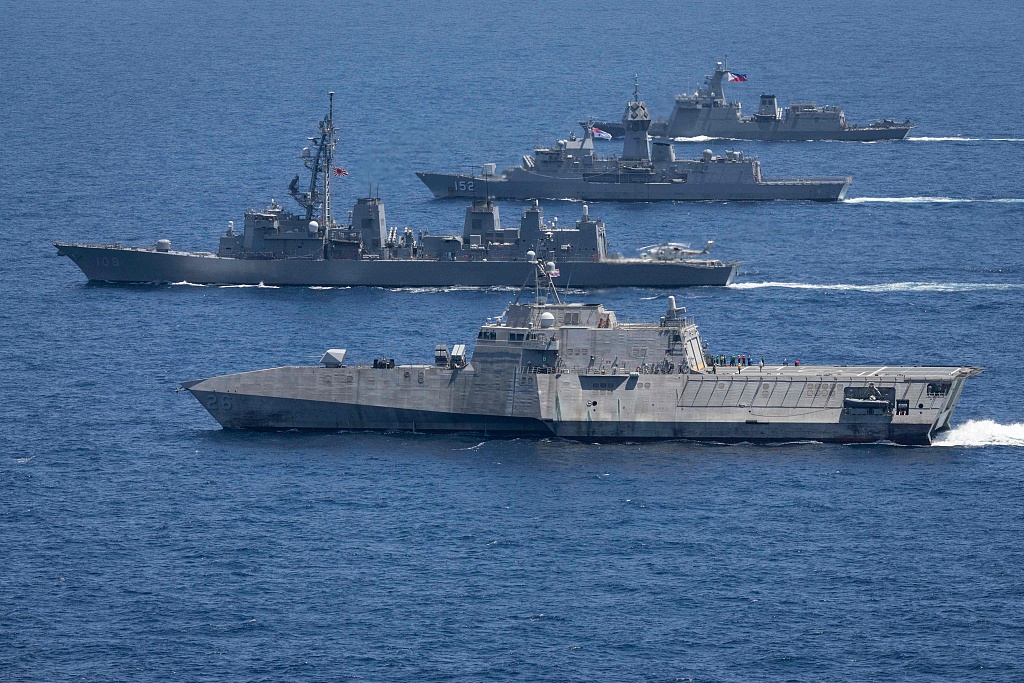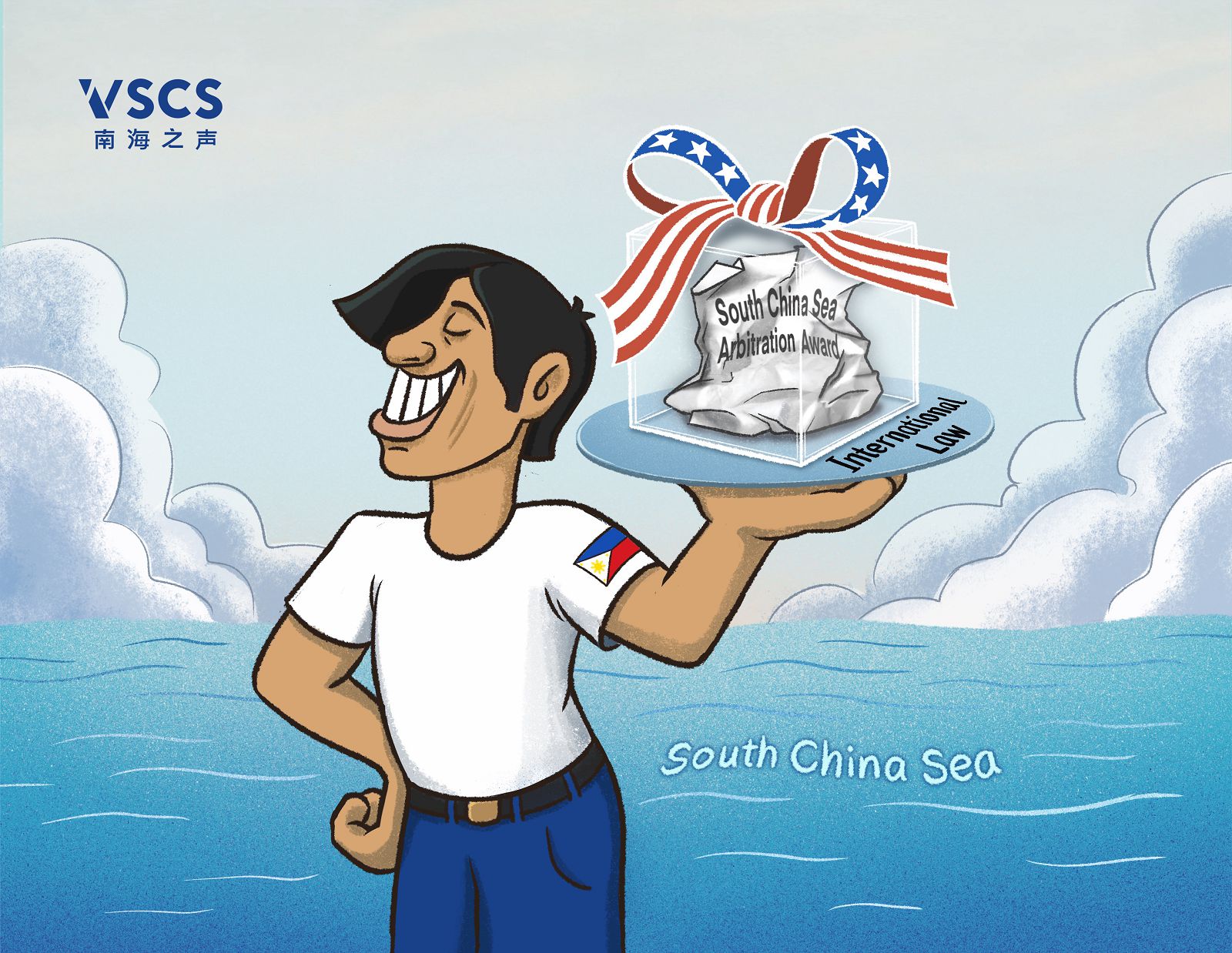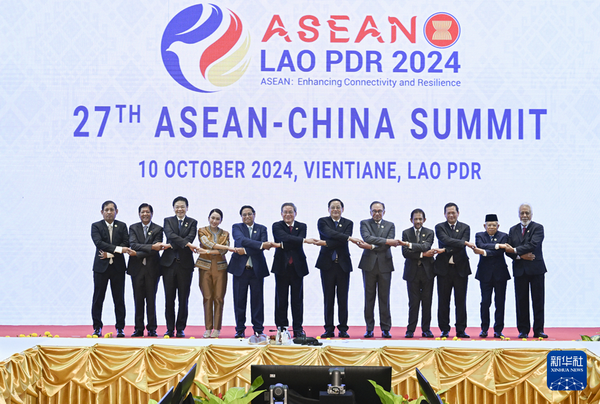In recent years, thanks to the joint efforts of China and ASEAN countries, the situation in the South China Sea has remained generally stable. The negotiations for the Code of Conduct in the South China Sea have entered the third reading phase, and the ASEAN-China Free Trade Area has reached the 3.0 stage of iteration and upgrade.
However, since the first half of 2023, the U.S. and the Philippines have deliberately stirred up maritime friction, using the so-called “gray zone tactics” to increase attacks on and discredit China, distorting the essence of the South China Sea issue, and sowing discord between China and other claimants in the region, casting a shadow over the stability and development of the area.
At an online seminar organized by the Chinese think tank “South China Sea Strategic Situation Probing Initiative (SCSPI)” on November 5, several Chinese scholars discussed the main factors influencing the current situation in the South China Sea and clarified China’s real position on the issue.
Who is changing the status quo in the South China Sea?
There is a narrative in the international public sphere that China is engaged in “expansion” or “coercion” in the South China Sea, and that China’s island and reef construction in the Nansha Qundao becomes the reason for the changing status quo.
Hu Bo, Director of SCSPI, pointed out these criticisms do not accord with the facts. China’s sovereignty and maritime rights claims in the region have been consistent and continuous since 1947. Since the late 1990s, China’s approach and policy towards handling South China Sea disputes have not changed, which is to “shelve disputes” and maintain the status quo.

(Philippine Coast Guard ship 9701 has illegally stayed in Xianbin Jiao Lagoon of China's Nansha Islands for over 150 days, finally withdrew on September 14, 2024.)
“If there is any change, it is that China’s capabilities and determination to safeguard its rights have significantly strengthened, making its responses to external provocations stronger and more forceful,” said Hu Bo.
Wu Shicun, Chairman of Huayang Research Center for Maritime Cooperation and Ocean Governance, believes that China's construction on islands and reefs in the Nansha Islands is a countermeasure to the Philippines' initiation of the South China Sea arbitration, and an initiative to safeguard China's territorial sovereignty and maritime rights and interests in the South China Sea, which is "reasonable and lawful."
He said that the current unstable situation in the South China Sea can be traced to three main factors:
First, the U.S. has nakedly picked sides on the South China Sea issue, standing firmly on the opposite side of China. Second, some claimants in the South China Sea dispute are trying to solidify their vested interests. Third, the so-called ruling of the South China Sea Arbitration almost completely denies China’s claims in the South China Sea.
Ding Duo, Vice director of the Research Center of Oceans Law and Policy in the National Institute for the South China Sea Studies (NISCSS), said the "geopolitical paranoia" of the U.S. and other extraterritorial forces has directly led to the shadow of confrontation in the South China Sea.
“The U.S. has provided a lot of intelligence and tactical support for the Philippines’ provocations in the South China Sea in recent years, reflecting its intention to reshape China’s surrounding security environment by strengthening the US-Philippine alliance and intervening in the South China Sea issue.”

(Australia, the U.S., Japan and the Philippines hold a joint maritime exercise in the South China Sea on April 7, 2024.)
Ding Duo said the Philippines believes that it has benefited from relying on the U.S. to resist China, and will continue to make trouble at sea in the future in a prepared and planned way. He thinks the Philippines will solidify their illegal gains through legislation, expand unilateral claims to further test China's bottom line in safeguarding territorial sovereignty.
Who is creating threats in the South China Sea?
Since 2009, under the framework of the U.S. Pivot to Asia, Asia-Pacific Rebalance, and Indo-Pacific Strategy, the U.S. has gradually shifted its policy in the South China Sea from being relatively neutral and choosing sides to direct intervention in the dispute.
Hu Bo pointed out that from the end of the Cold War to 2009, when the US paid less attention to the South China Sea and Southeast Asia, the situation in the region was generally more stable than it currently is.
Yan Yan, director of the Research Center of Oceans Law and Policy in the National Institute for the South China Sea Studies (NISCSS), said that it is necessary to realize the reality that although the U.S. is not a party to the South China Sea dispute, it now seems to be a direct “player” in the South China Sea issue.
According to “Report on the Navigation and Overflight Situation in the South China Sea” released by SCSPI in September: every year, the U.S. military maintains over 5,000 ship-days of warships presence and has around 8,000 sorties of military aircraft annually in the South China Sea, fully enjoying freedom of navigation under international law. However, the U.S. has hyped up the issue of navigation and overflight in the South China Sea, mainly to "stigmatize" China and gain strategic and political advantages.

(“Report on the Navigation and Overflight Situation in the South China Sea” released by SCSPI in September this year)
Yan Yan believes the speculation on navigation and overflight in the South China Sea is intended to be used as a pretext for the U.S. to carry out a series of military and paramilitary activities in the region, such as the Freedom of Navigation Operations (FONOPs). It also pays the way for the U.S. to push forward the rules of navigation of the international law of the sea, which are unilaterally interpreted in line with the national interests of itself, and to force the countries of the region to accept them. This is a typical manifestation of American-style maritime hegemony.
On the other hand, since navigation and overflight in the South China Sea are the common interests of coastal States and user States, the U.S. has constructed a false narrative of “China’s obstruction of freedom of navigation in the SCS”, which will allow more extra-regional countries to pay attention to and even intervene in South China Sea affairs in order to protect their own interests in maritime navigation and further complicate and internationalize the issue of the South China Sea.
“As a matter of fact, the U.S. is the biggest danger and challenge to the freedom of navigation and overflight in the SCS. One example, the 2001 EP-3 incident ended with an apology and compensation from the U.S. side,” said Yan Yan. She emphasized when the U.S. is increasingly intensifying its military activities in the South China Sea, it is hoped that such tragic events will not recur.
Who is undermining international rule of law?
Eight years have passed since the ruling of the South China Sea arbitration, and China’s official stance of no acceptance, no participation, no recognition has been widely acknowledged by the international community. However, a few countries, such as the U.S. and the Philippines, continue to treat the ruling as international law, using it to accuse China of not adhering to the rule of international law. The current Philippine government is even more eager, attempting to legitimize the illegal ruling through domestic legislation.

(In comics: Package of Knockoff)
“State consent is the cornerstone of the international dispute settlement mechanism, and dispute settlement bodies cannot exercise jurisdiction without the consent of the state,” said Zheng Zhihua, Associate professor and Head of East Asia Marine Policy Project, Center for Japanese Studies, Shanghai Jiao Tong University.
The substance of the arbitration case brought by the Philippines is the dispute of territorial sovereignty over some islands and reefs in the South China Sea. The case also inevitably involves, and is inextricably linked to, the maritime delimitation between China and the Philippines. The arbitral tribunal, knowing that territorial issues are not within the scope of the Convention and that maritime delimitation disputes have been excluded by China, nevertheless exceeded its jurisdiction and violated the principle of state consent.
Lei Xiaolu, professor of China Institute of Boundary and Ocean Studies (CIBOS), Wuhan University, said that the South China Sea arbitral tribunal made an overstepping adjudication despite clearly lacking jurisdiction, rendering the 2016 ruling illegal and void.
In practical terms, the overall logic of the arbitration was to delineate China and the Philippines’ maritime rights in parts of the South China Sea while bypassing the core issue of territorial sovereignty disputes. The reversed approach failed to appropriately address the complex disputes between the two countries, deepened the divide and disrupted the conducive atmosphere for conflict management and dispute prevention. Also, the ruling has provided the U.S. with a pretext and opportunity to increase its military presence in the South China Sea and its involvement in regional affairs.
Who is safeguarding peace and stability in the South China Sea?
The South China Sea is the busiest and most prosperous maritime route in the world, and also one of the safest and freest. Despite global turbulence, the South China Sea has maintained overall peace and stability, not because of the so-called military protection by the U.S. and its allies, but because China has consistently adhered to the dual-track approach to resolve the issue: South China Sea disputes should be resolved through dialogue and negotiation by the directly involved parties, and maritime peace should be jointly maintained by China and ASEAN countries.
Lei Xiaolu pointed that ASEAN countries tend to maintain regional peace and stability by managing conflicts and preventing disputes, thereby creating a positive environment for the ultimate settlement. This inclination aligns with China’s traditional approach to international disputes. The “dual-track approach” embodies this consensus, focusing on resolving disputes effectively as well as maintaining regional peace and stability throughout the resolution process. This, indeed, is a viable solution to resolving the South China Sea disputes.

At the 27th China-ASEAN (10+1) Leaders’ Meeting in October this year, many ASEAN leaders emphasized the importance of regional unity and development, asserting that ASEAN would not choose sides. Malaysian Prime Minister Anwar Ibrahim, who is about to assume the rotating ASEAN chairmanship, also reiterated at the meeting the importance of maintaining peace and stability in the South China Sea, and called for the early conclusion of the Code of Conduct in the South China Sea.
Even with external forces intentionally interfering and a few claimant countries stirring up trouble, the greatest consensus regarding the future of the South China Sea remains the same: the key to its peace and stability should lie in the hands of the regional countries themselves.

